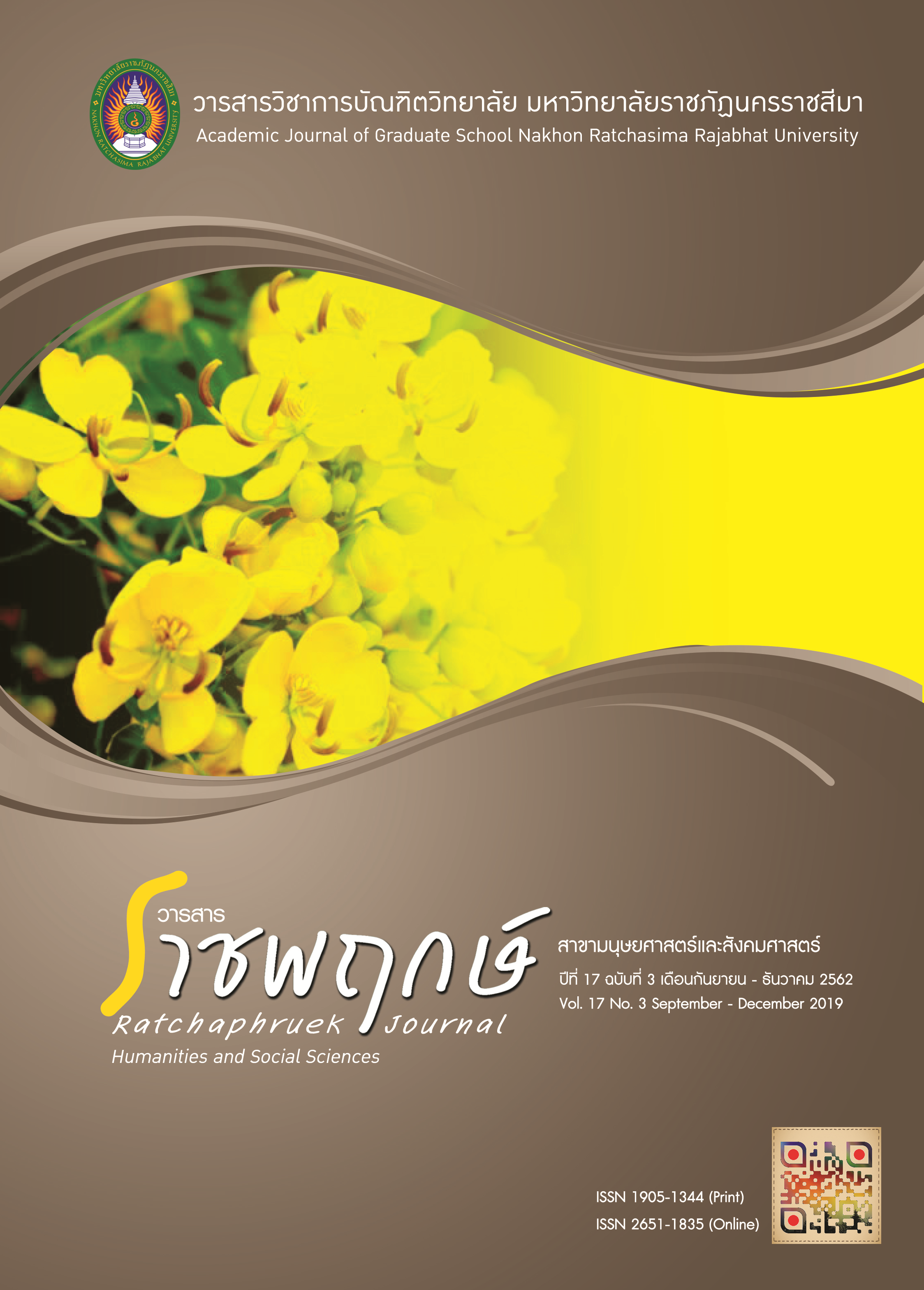การพัฒนารูปแบบการจัดการเรียนรู้แบบแวดวงวรรณกรรมร่วมกับการใช้คำถามระดับสูงเพื่อพัฒนาความสามารถด้านการคิดวิเคราะห์ของผู้เรียนในระดับอุดมศึกษา
Main Article Content
บทคัดย่อ
บทคัดย่อ
การวิจัยครั้งนี้มีวัตถุประสงค์ 1) เพื่อพัฒนารูปแบบการจัดการเรียนรู้แบบแวดวงวรรณกรรมร่วมกับการใช้คำถามระดับสูงเพื่อพัฒนาความสามารถในการคิดวิเคราะห์ของผู้เรียนระดับอุดมศึกษา 2) เพื่อเปรียบเทียบความสามารถในการคิดวิเคราะห์ของนักศึกษาคณะครุศาสตร์ มหาวิทยาลัยราชภัฏ สุราษฎร์ธานี ก่อนและหลังได้รับการจัดการเรียนรู้แบบแวดวงวรรณกรรมร่วมกับการใช้คำถามระดับสูง กลุ่มตัวอย่าง คือ นักศึกษาคณะครุศาสตร์ มหาวิทยาลัยราชภัฏสุราษฎร์ธานี ปีการศึกษา 2559 จำนวน 4 กลุ่มเรียน 130 คน กลุ่มตัวอย่างได้มาโดยการเลือกแบบเจาะจง โดยทั้ง 4 กลุ่มเรียนเป็นกลุ่มทดลอง ใช้เวลา 10 สัปดาห์ สัปดาห์ละ 3 คาบ รวม 30 คาบ/วิชา เครื่องมือที่ใช้ในการเก็บรวบรวมข้อมูล คือ แบบทดสอบความสามารถในการคิดวิเคราะห์ และเครื่องมือที่ใช้ในการทดลอง คือ แผนการจัดการเรียนรู้แบบแวดวงวรรณกรรมร่วมกับการใช้คำถามระดับสูง วิเคราะห์ข้อมูลโดยหาค่าเฉลี่ยมัชฌิมเลขคณิต () ส่วนเบี่ยงเบนมาตรฐาน (S) และทดสอบค่าที (t-test) ผลการวิจัยพบว่า 1) รูปแบบการจัดการเรียนรู้แบบแวดวงวรรณกรรมร่วมกับการใช้คำถามระดับสูงเพื่อพัฒนาความสามารถในการคิดวิเคราะห์ มีกระบวนการจัดการเรียนการสอน 5 ขั้น คือ (1) สำรวจความรู้เดิมและแบ่งกลุ่ม (2) ค้นคว้าและตั้งคำถาม (3) พิจารณาคำตอบ (4) สะท้อนผล และ (5) นำเสนอผลการวิเคราะห์ข้อมูล 2) นักศึกษาที่ได้รับการจัดการเรียนรู้แบบแวดวงวรรณกรรมร่วมกับการใช้คำถามระดับสูงมีความสามารถในการคิดวิเคราะห์หลังเรียนสูงกว่าก่อนเรียนอย่างมีนัยสำคัญทางสถิติที่ระดับ .05 และมีความสามารถในการคิดวิเคราะห์ทั้ง 3 ด้าน ได้แก่ ด้านความสำคัญ ด้านความสัมพันธ์ และด้านหลักการ หลังเรียนสูงกว่าก่อนเรียนอย่างมีนัยสำคัญทางสถิติที่ระดับ .05
Article Details
เอกสารอ้างอิง
ฆนัท ธาตุทอง. (2554). สอนคิด: การจัดการเรียนรู้เพื่อพัฒนาการคิด. นครปฐม: เพชรเกษมการพิมพ์.
ปิยะพงค์ โชติพันธุ์. (2556). การสอนเพื่อพัฒนาทักษะการคิดขั้นสูง. จุลสาร PBL วลัยลักษณ์
มหาวิทยาลัยวลัยลักษณ์. 6(1),น. 8-9.
พันธ์ศักดิ์ พลสารัมย์. (2546). การปฏิรูปการเรียนการสอนระดับอุดมศึกษา: การพัฒนากระบวนการ
เรียนรู้ในระดับปริญญาตรี. วารสารเซนต์จอห์น มหาวิทยาลัยเซนต์จอห์น. 6(6), น.1-15.
วรรษชล พิเชียรวิไล. (2561). ผลการจัดการเรียนการสอนตามแนวคิดคอนสตัคติวิสต์
ต่อความสามารถในการคิดวิเคราะห์ของนักศึกษาพยาบาลศาสตร์. วารสารวิทยาศาสตร์
และเทคโนโลยี มหาวิทยาลัยสุรนารี. 12(1), น.37-47.
ศรเนตร อารีโสภณพิเชฐ. (2557). กลยุทธ์การเรียนการสอนเพื่อพัฒนาทักษะการคิดวิเคราะห์ : แผนที่
มโนทัศน์. วารสารครุศาสตร์ จุฬาลงกรณ์มหาวิทยาลัย. 42(3)น 194-210.
สำนักทดสอบทางการศึกษา. (2557 ). สรุปผลการประเมินคุณภาพภายนอกรอบสาม(พ.ศ. 2554 -
2558) ของสถานศึกษา สังกัดสำนักงานคณะกรรมการการศึกษาขั้นพื้นฐาน ปี พ.ศ. 2554.
สืบค้นเมื่อ 1 สิงหาคม 2560 จาก https://www.docdroid.net/z4YkGdn/1-3-web.pdf
สุวิทย์ มูลคำ. (2556). กลยุทธ์การสอนคิดวิเคราะห์. พิมพ์ครั้งที่ 4. กรุงเทพฯ: ภาพพิมพ์
อดิศา เบญจรัตนานนท์. (2560). การจัดการเรียนการสอนภาษาอังกฤษพื้นฐาน
มหาวิทยาลัยสงขลานครินทร์ วิทยาเขตปัตตานี: เสียงสะท้อนจากผู้เรียนและผู้สอน.
วารสารวิชาการคณะศึกษาศาสตร์ มหาวิทยาลัยศรีนครินทรวิโรฒ. 18 (2),น. 293-315.
อาร์ม โพธิ์พัฒน์. (2550). การศึกษาผลสัมฤทธิ์ทางวิทยาศาสตร์และความสามารถในการคิด
วิเคราะห์ของนักเรียนชั้นมัธยมศึกษาปีที่ 3 ที่ได้รับการสอนโดยใช้ชุดกิจกรรมการเขียน
แผนผังมโนคติ. (วิทยานิพนธ์มหาบัณฑิต มหาวิทยาลัยศรีนครินทรวิโรฒ).
Bloom et al. (1976). Taxonomy of Education Objectives. Handbook I Cognitive Domain.
New York : Divid Mclay Company.
Daniels, H. (1994). Literature Circles: Voice and Choice in the Student-Centered
Classroom. York, Maine: Stenhouse Publishers.


